| dc.description.abstract | Habitat selection is a context-dependent mechanism, in which both the internal state as well as external factors affect the behavior and decisions of an individual. This is well known for polygamous mammals, which are typically sexually dimorphic, and often express great variability in behavior and habitat selection between individuals as well between the sexes. Among monogamous mammals, however, variability in habitat selection should be explained by group characteristics and the presence of offspring rather than by sex. We evaluated this hypothesis in a socially monogamous rodent, the Eurasian beaver (Castor fiber), in a saturated Norwegian population. For the first time in this species we applied GPS tracking devices (N = 22 adult beavers, in 15 territories, 2009–2013), and used resource selection functions (i) to document population-wide habitat selection and the importance of ‘territory’ therein, and (ii) to evaluate which socio-ecological factors explained potential individual differences in habitat selection. We found that variation in habitat selection was stronger between territories than between years or individuals nested by territory. We identified that family size and the presence of kits, but not sex, explained individual variation in habitat selection. Adults with kits and/or larger families tended to exhibit low risk-taking behavior (avoiding human-related variables such as roads, buildings, and agricultural land), and stayed close to their main lodge (parental care). Our results show that habitat selection is a context-dependent mechanism even in a species which expresses very little behavioral and morphological dimorphism. | |


